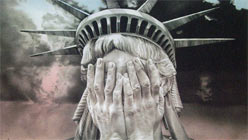What is the role of the artist in wartime? Answers to that question are many, but all are conditional. It is absurd to speak about “the artist” as monolithic. Artists’ strategies for interacting with the real are as varied as the artists themselves. It might be equally absurd to speak of war in a similar fashion. Throughout history, wars have been waged for a multitude of reasons, the specifics of which we leave to the province of historians who, with distance and hindsight, are better able to piece together the logics of victor and vanquished.
War is eternal. It is constant, like a heartbeat, an ever-present part of the human condition. It is always with us, staining the whole of human history with the blood spilled. War is epic. It is drama on a grand scale, which is why it appears so often in works of art.
The Meridian Gallery’s current exhibition, Art of Democracy: War and Empire, fills three floors with artworks that explore the subject of war in general, and grapple with the current Iraq war in particular. Forty artists contributed to the exhibition, deploying a number of strategies, only a few or which are, in my opinion, successful.
Many of the works in the show are loud and graphic, depicting battlefield scenes or instances of atrocity and abuse. They put the bloody reality front and center, confronting the viewer with the ugly barbarism of battle. Others employ a gallows humor, mocking the warmongers (mostly members of the Bush Administration), twisting the players into grotesque caricatures and scrawling their own nonsensical rhetoric across their mouths. It is as if the artists are attempting to shove the coarse words back down the throats that uttered them.
There is probably a cleansing function to this art. The anger and outrage must be exorcised in some way, but one wonders what this art is attempting. Is it educational? Informational? It is surely not being produced to change minds. Perhaps it is meant more as a rallying cry or, in some cases, an outcry. One cannot help but think that this work just feeds the thing it aims to combat.


